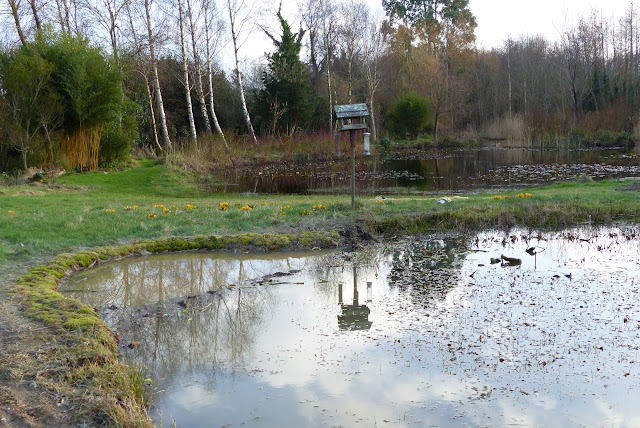"Another pond?" this was the most frequent phrase to be heard from those friends and family that were able to visit us last year (in the brief interludes between lockdowns). Nothing on our previous scale this time though!
In January 2020, while the bees were hibernating from the cold and much flora and fauna were dormant, there was a good spell of dry weather when there was a window of opportunity to make a new pond. It’s close to the house and much smaller than the others, it has since been nicknamed the puddle!
 |
| Here it is in the foreground in January 2021. Scroll on to see some of the upheaval involved in its creation.... |
 |
| The secret to a clay lined pond is in the puddling, squashing out air pockets and compacting the clay to form an impermeable layer. |
 |
| January 31st 2020 And puddling is great fun when you're 8! |
 |
| February 4th 2020. The existing pond with small extension visible, the dividing bank being gently dug out by hand. |
 |
| February 6th 2020. There were many mounds of soil to move after the initial dig with the excavator. |
 |
| February 7th 2020. I raked a very thin layer of the excavated soil over the whole area. I admit, the project did involve a considerable amount of manual work! |
 |
| April 18th 2020. Puddling is also fun when you're nearly 48! The puddling continued throughout the spring. |
 |
| May 4th 2020. The overflow pipe for rain water coming from the barn area is just visible on the left of this photo. The exceptionally dry spring delayed germination of the native seed bank. |
 |
| June 8th 2020. Although we didn’t plant seeds, I transplanted some wild seedlings that were coming up in the garden beds to compliment the existing seed bank in the soil. |
 |
| July 1st 2020. |
 |
| October 30th 2020. The new pond reflecting on the year that was! |
All the ponds here have been made without artificial liners. The large pond lies low in the landscape, essentially kept full by the water table. The smaller ponds are puddled with clay and are on slightly higher ground, they are kept topped up by pipes carrying rain water from the house and barn roofs.
Although there is a small stream that borders the garden, the ponds are kept separate from it. The ponds overflow first into each other and finally into a small area of natural bog. The bog is naturally flooded in the winter and usually dries up in the summer.
Natural water in the garden requires sensitive planting, we have had to learn to identify and manage volunteer species that are locally invasive. Initially Angus managed the wild pond area while I grew vegetables and flowers near the house. In recent years my enthusiasm for plants has extended and with it the area I care for. Yet water gardening is a journey that I feel I am only beginning. There will be trials and tribulations to follow no doubt.






